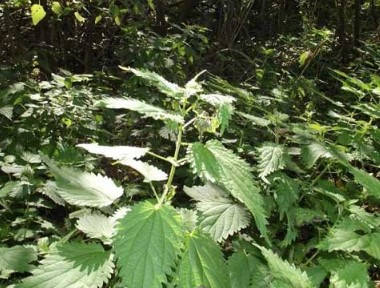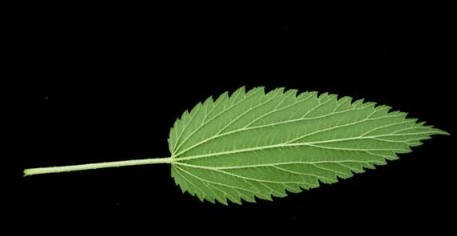Ecology of stinging nettle
Stinging nettle (Urtica dioica) is a slow-growing perennial plant native to North America (Figure 1). There are other types of stinging nettle in the U.S. and around the world. All of the stinging nettle species have hairs on the stem and leaves that cause discomfort and inflammation to humans. Stinging nettle species were once classified in the same botanical as hemp, but botanists now consider hemp and nettles to be different families.

Figure 1. Typical growth habit of stinging nettle. Photo credit: R. Gardner and D. Cappaert, Bugwood.org.
Some identifying features of stinging nettle are it’s 4-angled, ridged, hairy stem (Figure 2-top photo). It can grow up to nine feet tall with an extensive system of rhizomes. Leaves are oval-shaped, toothed, and oppositely arranged on the stem (Figure 2-bottom photo). Both sides of the leaves are covered in hairs; leaves on the upper surface tend to be appressed, or flattened, while the bristly, stinging hairs occur mostly along the three main veins on the lower leaf surface. Stinging nettle flowers are inconspicuous and produced at the base of leaves on the upper branches. Male and female flowers grow on separate plants. Stinging nettle is typically found in disturbed, shady sites with moist but well-drained soils having high fertility.


Figure 2. Upper photo: Stinging nettle stem. Bottom photo: Stinging nettle leaf. Photo credit: R. Gardner and D. Cappaert, Bugwood.org.
The chemicals in the stinging hairs that cause the irritation are acetylcholine, histamine, and serotonin. Some suggest that applying rubbing alcohol to the affected area can relieve irritation. Large doses of these chemicals can cause respiratory distress and irregular heartbeat. Records from the 1500s suggest that stinging nettle was considered a cure for maladies ranging from tuberculosis to rheumatism to baldness.
Stinging nettle was farmed in Europe to provide fibers during World War I. Today, extracts are used in some antidandruff shampoos and have been proposed as a dietary supplement for farmed fish. In fact, there are far more research papers published about beneficial uses of stinging nettle than weed management!
Management
Research reports suggest that fall or spring applications of glyphosate or applications of oxyflurofen (Colide, Galigan, Goal, and others) to small, actively growing plants will control stinging nettle. Other research suggests that vigorous turfgrass will outcompete stinging nettle. Because stinging nettle is adapted to disturbed areas, population increases were observed after burning rangeland.
Source : kstate.edu